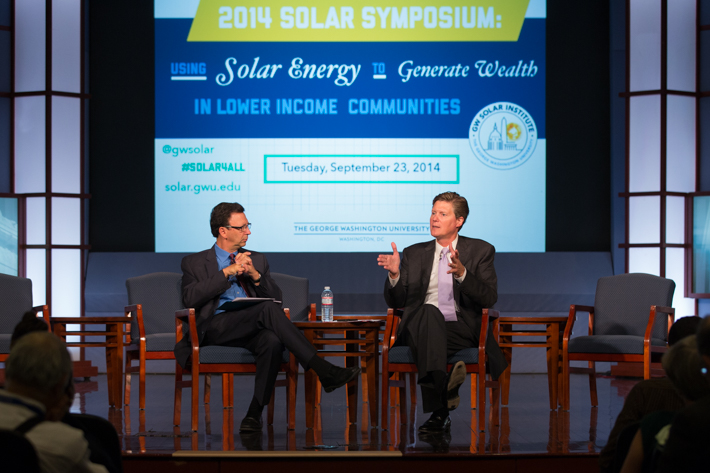#Solar4All was a fitting social media tag for the sixth annual Solar Symposium held Tuesday at the George Washington University where policymakers, practitioners, faculty and students gathered for the GW Solar Institute conference to tackle one question:
“How do we improve access to solar technology in low-income communities?”
The cost of purchasing and installing solar panels has decreased by 64 percent since 2010, according to research by the Solar Energy Industry Association (SEIA).
However, only 5 percent of families with an income less than $40,000 a year have access to solar power because they don’t own their homes or rooftops for installation or don’t have good enough credit to secure a loan—making the benefits of installing solar panels exclusive to high-income earners.
“Even if solar panels were free, we would still have many of the same barriers to installing solar power in low-income communities,” GW Solar Institute Director Amit Ronen said. “We need innovation, creativity and investment in this area.”
Rhone Resch, SEIA president and CEO, said that the absence of national and state policy supporting low-income solar investment is a major roadblock to making solar energy “the people’s power.”
People in low-income communities are also shut out of leasing solar energy equipment because they often lack sufficient credit, Mr. Resch said. The leasing option allows a pay-by-the-month plan for solar power installation, Mr. Resch said.
He added that because the solar industry is expanding to include panel installations at nonprofit organizations, churches and schools and in residential areas—the process is becoming less costly and could become more accessible to low-income communities.
In 2013, the industry saw 42 percent growth, according to SEIA.
“It’s a basic business model,” Mr. Resch said. “As you scale up manufacturing, you have a lower cost-per-unit. Now everyone can do something about his or her own carbon footprint”.
But Frank Sesno, founder of Planet Forward and director of the School of Media and Public Affairs, was skeptical of whether environmental gains alone would drive lower-income earners to solar power.
“Low-income folks are trying to decide how to pay bills each month,” Mr. Sesno said during a discussion with Mr. Resch. “At the top of their minds isn’t ‘I can reduce my carbon footprint,’ but…might be, ‘I can reduce my electric bill.’”
Conference panelists pointed out that providing proper incentives for solar installation in lower-income households is key to expanding the number of solar power users. Many “extremely low-income” families rent multifamily homes where utility costs are fixed at 30 percent of their income through the Department of Housing and Urban Development’s Section 8 program.
As a result, panelists said, lowering those families’ utility bills through solar power would result in them paying higher rents in order to maintain the 30 percent formula.
Panelists such as Erica Mackie, co-founder and CEO of nonprofit organization Grid Alternatives, said that federal policymakers should consider how to better prioritize low-income communities when creating solar investment policy.
Panelists also concluded that policymakers should incorporate solar technology incentives into existing housing subsidization programs for low-income communities, such as HUD’s Section 4 affordable housing grant program.
Grid Alternatives, a partner of the Solar Institute, takes a hybrid approach by assisting communities with solar panel installation and training residents of low-income neighborhoods for jobs in the solar industry. It was founded in 2001 during the California energy crisis, which saw rapidly increasing energy prices and power shortages.
The nonprofit organization recently opened a mid-Atlantic office in D.C. and is currently installing solar in the Ivy City section of Northeast D.C. Symposium attendees toured the site on Monday.
“There isn’t just one answer,” Ms. Mackie said. “But when we design federal policy around solar, we need to ask one question, ‘How do we create policy that benefits low-income communities?’”
“Community solar investment” also surfaced as a potential solution for increasing solar power in low-income areas. Mr. Resch said that pairing higher-income, middle-income and lower-income earners through community solar investment increases their average credit rating, which improves the chances for solar investment.
Conference attendees incorporated these suggestions into a list of recommendations following discussions with experts, government officials representing HUD, the the departments of energy and agriculture, top officials from pioneering clean energy states, New York and Connecticut and presentations on solar innovations moderated by GW Sustainability Institute Executive Director Kathleen Merrigan.
“Low-income families want and deserve to share in the benefits of using solar energy, but there is still a lot of work to do to make solar energy accessible for all Americans,” Dr. Ronen said. “Bringing together for the first time the nation’s leading low-income solar experts and decision-makers was a key step to identifying ways to turn these challenges into opportunities.”


